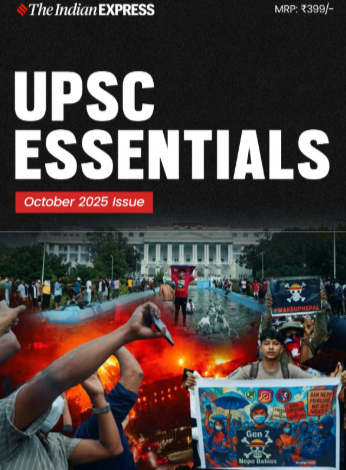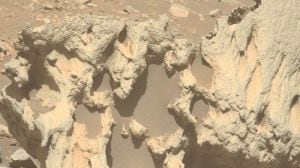
Preliminary Examination: Current events of national and international importance
Mains Examination: General Studies-II: Effect of policies and politics of developed and developing countries on India’s interests, Indian diaspora.
Story continues below this ad
What’s the ongoing story: US President Donald Trump received Saudi Crown Prince Mohammed bin Salman at the White House on Tuesday, as the two leaders looked to strengthen security ties, expand business cooperation and discuss the future of US-Saudi relations.
Key Points to Ponder:
— What are the features of F-35 fighter jets?
— What is Saudi Vision 2030?
— What is Abraham Accord?
— Has Saudi joined the Abraham Accord?
— What is the issue around the killing of Jamal Khashoggi?
— What are the areas of cooperation and conflict between Saudi and the USA?
— What is Trump’s Gaza plan?
— What is the significance of a stable Middle East for India?
Story continues below this ad
— A Saudi-Israel normalisation and an expanded Abraham Accords could herald a different political architecture for the Middle East. What do you understand from this statement?
Key Takeaways:
— The visit is the crown prince’s first to the White House in more than seven years.
— Talks are expected to focus on defence cooperation, civil nuclear projects and major business deals. A senior US official told Reuters the two countries were preparing agreements on defence sales, nuclear energy cooperation and a multibillion-dollar Saudi investment in US artificial intelligence infrastructure.
— Trump told reporters on Monday that the United States “will be selling” F-35 fighter jets to Saudi Arabia. The kingdom has asked to buy 48 of the aircraft. If approved, this would be the first US sale of F-35s to Saudi Arabia and could reshape military dynamics in the Middle East, where Israel has so far been the only country in the region with the jets.
Story continues below this ad
— The meeting comes as the fallout from the 2018 killing of US-based journalist Jamal Khashoggi has eased internationally. US intelligence concluded that the crown prince approved the capture or killing of Khashoggi at the Saudi consulate in Istanbul. He has denied ordering the operation but has said he accepts responsibility as Saudi Arabia’s de facto ruler.
— Relations between Washington and Riyadh were strained after the killing, but the ceremony and schedule surrounding Tuesday’s visit, including Oval Office talks, a Cabinet Room lunch and a formal black-tie dinner, signal that ties have improved.
— Saudi Crown Prince Mohammed bin Salman’s (MbS) visit to Washington this week marks an inflexion point in the evolution of US-Saudi relations and raises hopes for a radical transformation of the Middle East.
— For MbS, the visit is also about securing valuable American support for his own looming succession. King Salman, now 89, is frail and has long delegated day-to-day governance to his son.
Story continues below this ad
— MbS has sidelined most potential rivals within the royal family, but he must still ensure that nothing disrupts the establishment of a durable “Salman line” within the House of Saud. American endorsement could be critical.
— Equally important for MbS is strong US backing for his sweeping Vision 2030 agenda. At the heart of his ambition is the transformation of Saudi Arabia from an extractive state into a diversified, globally competitive economy and a more open society.
— In a turbulent region, MbS also seeks solid security assurances from Washington. With the US Senate opposed to a formal defence treaty, Riyadh is pursuing an intergovernmental agreement with the Trump administration.
— Civil nuclear cooperation is another priority. Atomic accord with America is not just about diversifying the kingdom’s energy sources, but also a symbolic parity with regional rival Iran that has built a vast nuclear programme.
Story continues below this ad
— MbS also wants Washington to acknowledge Saudi Arabia’s new self-image as a rising regional and global actor. He has shed the famously passive Saudi foreign policy of the past and is determined to step out as a consequential player in the Middle East and beyond.
— For the US, Saudi Arabia remains an indispensable partner. Washington needs Riyadh’s cooperation in stabilising the Middle East and retaining US primacy. More immediately, Trump wants Saudi recognition of Israel and the expansion of the Abraham Accords.
— A Saudi-Israel normalisation and an expanded Abraham Accords could herald a different political architecture for the Middle East. India, which has good relations with both Israel and Saudi Arabia and is a strong supporter of the Abraham Accords, can only benefit from the normalisation of ties between Tel Aviv and Riyadh and participation in a new era of peace and prosperity in the Middle East.
— Yet Israel’s reluctance to concede even minimally on Palestinian statehood, and the resistance of its supporters in Washington to any American grand bargain with MbS, means expectations of a dramatic breakthrough must be tempered.
Do You Know:
Story continues below this ad
— Abraham Accords are a series of agreements signed in September 2020 to normalise relationship between Israel and other Arab nations.
— India is the second largest trade partner of Saudi Arabia, whereas the kingdom is the fifth largest trading partner of India. In FY 2023-24, bilateral trade stood at USD 42.98 billion, with Indian exports at USD 11.56 billion and imports at USD 31.42 billion.
— Bilateral trade ties have steadily grown over the years. India is the second largest trade partner of Saudi Arabia whereas Saudi Arabia is the fifth largest trading partner of India.
— In FY 2023-24, bilateral trade stood at USD 42.98 billion, with Indian exports at USD 11.56 billion and imports at USD 31.42 billion.
Story continues below this ad
— Indian investments in Saudi Arabia have also increased in recent years, reaching a cumulative figure of approximately USD 3 billion in August 2023. The Saudi investment in India including that of PIF, other Saudi companies and Saudi backed Vision Fund, has been about USD 10 billion.
Other Important Articles Covering the same topic:
📍The importance of Saudi Arabia to India
📍Abraham Accords have led to greater regional cooperation, expanding opportunities for India
Previous year UPSC Prelims Question Covering similar theme:
(1) Consider the following statements: (UPSC CSE 2023)
Statement-I: Israel has established diplomatic relations with some Arab States.
Statement-II: The ‘Arab Peace Initiative’ mediated by Saudi Arabia was signed by Israel and Arab League.
Story continues below this ad
Which one of the following is correct in respect of the above statements?
(a) Both Statement-I and Statement-II are correct and Statement-II is the correct explanation for Statement-I
(b) Both Statement-I and Statement-II are correct and Statement-II is not the correct explanation for Statement-I
(c) Statement-I is correct but Statement-II is incorrect
(d) Statement-I is incorrect but Statement-II is correct
Previous year UPSC Mains Question Covering similar theme:
“India’s relations with Israel have, of late, acquired a depth and diversity, which cannot be rolled back.” Discuss (UPSC CSE 2018)
NATION
Syllabus:
Preliminary Examination: Current events of national and international importance
Mains Examination: General Studies-II: Important International institutions, agencies and fora- their structure, mandate.
General Studies-III: Conservation, environmental pollution and degradation, environmental impact assessment
What’s the ongoing story: Ending the suspense over India’s next set of climate action plan, called Nationally Determined Contributions or NDCs in climate jargon, Environment Minister Bhupender Yadav said the country’s NDCs for the year 2035 will be finalised and released before the year-end deadline.
Key Points to Ponder:
— What are NDCs?
— What is BTR?
— What is the difference between NDCs and BTR?
— What are the main features of the Paris Agreement?
— What is the purpose of NDCs target?
— What is the status of Greenhouse gas emission from various countries?
— What are the initiatives taken by India to reduce greenhouse emissions?
— India’s NDC target (for 2030 has been) achieved five years ahead of schedule. What were the targets?
— Know about International Solar Alliance, Global Biofuel Alliance, Nuclear mission and green hydrogen mission
Key Takeaways:
— Yadav was making a national statement at the ongoing COP30 climate conference here. He said India had already achieved the targets it had set in its previous NDCs well ahead of schedule, setting an example for developed countries to follow.
— Yadav said along with its 2035 NDCs, India would also release its first Biennial Transparency Report (BTR), as mandated under the Paris Agreement. BTRs are part of reporting mechanism instituted under the Paris Agreement, though which countries are supposed to periodically provide information about their greenhouse gas emissions inventory…
— NDCs, on the other hand, are climate action plans that outline efforts to reduce greenhouse gas emissions and adapt to climate change impacts. Countries are required to update them every five years with progressively higher targets. India’s last NDC, for the period 2030, was announced in 2022 and the latest NDC is to be announced for the year 2035.
— “We shall be declaring our revised NDCs for 2035 and also the first Biennial Transparency Report (BTR), in line with the objectives of the Paris Agreement, by the end of the year,” Yadav said.
— There was a lot of expectation that India, the world’s third largest emitter of greenhouse gases, would release its 2035 NDC at the COP30 event, but Yadav said there was still some time, and India would announce the plan after getting the clearance of the Union Cabinet.
— The minister also stated that climate and energy sustainability initiatives adopted by India such as the International Solar Alliance and Global Biofuel Alliance have become global platforms for affordable and clean energy.
— He said that India’s newly launched nuclear mission and green hydrogen mission have also accelerated India’s journey towards reaching its net zero target by 2070. Net zero is a situation in which a country’s total emissions are balanced by carbon absorption or removals from the atmosphere. India has said it will achieve this status by 2070.
— “India’s non-fossil fuel-based energy capacity, currently around 256 Giga Watt (GW), accounts for more than half of its total electric store capacity (500 GW).
— Our NDC target (for 2030 has been) achieved five years ahead of schedule. India has demonstrated successfully that development and environmental stewardship can advance in tandem. India’s emission intensity has declined by over 36 per cent since 2005,” Yadav said in his speech.
Do You Know:
— The analysis by Centre for Research on Energy and Clean Air (CREA) for Carbon Brief, a UK-based climate-focussed publication, shows that the CO2 emissions from India’s electricity sector between January and June this year dropped 1 per cent compared to the first half of 2024.
— This is significant because the electricity sector is the largest contributor to India’s greenhouse gas emissions, accounting for almost 40 per cent of the country’s annual emissions. India’s emissions, the third largest in the world, have been rising steadily over the years, in sync with its expanding economy, and this is the first time that a drop has been witnessed even at the sectoral level.
— India is targeting 500 GW of installed non-fossil electricity capacity by 2030, of which 252 GW has already been achieved. Projects already in the pipeline, if executed before 2030, were enough to take the installed capacity to 482 GW, the analysis said.
Other Important Articles Covering the same topic:
📍First time, India’s CO2 emissions from power sector dip in Jan-June
📍How draft Greenhouse Gases Emissions Intensity Targets aim to help India meet climate goals
Previous year UPSC Prelims Question Covering similar theme:
(2) With reference to the Agreement at the UNFCCC Meeting in Paris in 2015, which of the following statements is/are correct? (UPSC CSE 2016)
1. The Agreement was signed by all the member countries of the UN and it will go into effect in 2017.
2.The Agreement aims to limit the greenhouse gas emissions so that the rise in average global temperature by the end of this century does not exceed 2°C or even 1.5°C above pre-industrial levels.
3. Developed countries acknowledged their historical responsibility in global warming and committed to donate $1000 billion a year from 2020 to help developing countries to cope with climate change.
Select the correct answer using the code given below.
(a) 1 and 3 only
(b) 2 only
(c) 2 and 3 only
(d) 1, 2 and 3
Previous year UPSC Mains Question Covering similar theme:
Discuss global warming and mention its effects on the global climate. Explain the control measures to bring down the level of greenhouse gases which cause global warming, in light of the Kyoto Protocol, 1997. (UPSC CSE 2022)
EXPLAINED
Syllabus:
Preliminary Examination: Economic and Social Development – Sustainable Development, Poverty, Inclusion, Demographics, Social Sector Initiatives, etc
Mains Examination: General Studies-III: Government Budgeting
What’s the ongoing story: India’s headline inflation rate, as measured by the Consumer Price Index (CPI), has been below the Reserve Bank of India’s (RBI) medium-term target of 4 per cent for nine months in a row and fell to a record low of just 0.25 per cent in October.
Key Points to Ponder:
— What is CPI?
— How is CPI inflation calculated?
— What is the role and function of the Monetary Policy Committee (MPC)?
— How is inflation calculated in India?
— What happens when there is a rise in inflation?
— What is the base effect?
— What is the basket of goods in CPI?
— Is gold included in the basket of goods of CPI?
— What is the proposed new base year for CPI?
Key Takeaways:
— And whether this will lead to the RBI’s Monetary Policy Committee (MPC) cutting the policy repo rate further in December or February 2026 will depend a lot on how India’s interest rate-setters interpret the underlying inflation data – for there is plenty that explains how inflation has fallen so low and could have been even lower.
— First, there is obviously the impact of the Goods and Services Tax (GST) cuts that came into effect on September 22. Economists estimate companies are yet to pass on the full benefit of the tax cut to consumers, and this will be reflected in the inflation data for November that will be released on December 12. Then there is the base effect, which was highly favourable not just in October but has been for much of 2025.

— According to calculations by The Indian Express, the favourable base effect in October was 133 bps – the joint second-strongest in 15 months. What this means is that headline retail inflation was 133 bps lower last month from September only because of how consumer prices moved in October 2024 – and they had moved up very sharply.
— Inflation is the percentage change in prices in a month compared to the same month last year. As such, the year-ago price is the denominator to calculate prices this year. If the prices last year were high, then that means the denominator is high – which exerts a downward force on the inflation rate this year.
— The opposite holds true when prices are either stable or declining in the year-ago period: the base effect is unfavourable and exerts upward pressure on the inflation rate.
— But this is the overall base effect – and the overall effect depends heavily on the base effect of the food index, which makes up 39 per cent of the CPI. For the Consumer Food Price Index, the favourable base effect was an even larger 256 bps in October.
— At present, CPI inflation is calculated by looking at price changes for 299 items; two of these items are gold and silver. Why? Because the consumption basket of households, which is what the CPI reflects, includes gold and silver.
Do You Know:
— Inflation refers to the rate at which the general price level for goods and services increases over a period of time, causing a decrease in purchasing power of money or real income. In other words, as inflation rises, each unit of currency can buy fewer goods and services than before.
— Rising inflation affects the financial well-being of households, especially those with lower incomes or fixed incomes. As the cost of goods and services increases, it reduces the quantity of goods and services that can be purchased with the same nominal income, thereby affecting households’ cost of living.
— Typically, inflation relates to consumer prices of all goods purchased by the consumer which may be either domestically produced or imported. The government publishes CPI each month. CPI measures changes over time in the general level of prices of goods and services that households purchase for consumption.
The formula for calculating inflation is ((CPI x+1 – CPI x )/CPI x ))*100.
CPI x = the value of the CPI in the initial/base year x.
— A base year is the first of a series of years in an economic or financial index. In this context, it is typically set to an arbitrary level of 100. New, up-to-date base years are periodically introduced to keep data current in a particular index. Base years are also used to measure the growth of a company. Any year can serve as a base year, but analysts typically choose recent years.
— A base year is used for comparison in the measure of business activity or economic or financial index. For example, to find the rate of inflation between 2016 and 2024, 2016 is the base year or the first year in the time set. The base year can also describe the starting point from a point of growth or a baseline for calculating same-store sales.
Other Important Articles Covering the same topic:
📍How inflation affects cost of living
📍New base year for GDP, CPI, IIP from early 2026; Services survey from Jan: MoSPI Secretary
Previous year UPSC Prelims Question Covering similar theme:
(3) Consider the following statements: (UPSC CSE 2020)
1. The weightage of food in Consumer Price Index (CPI) is higher than that in Wholesale Price Index (WPI).
2. The WPI does not capture changes in the prices of services, which CPI does.
3. Reserve Bank of India has now adopted WPI as its key measure of inflation and to decide on changing the key policy rates.
Which of the statements given above is/are correct?
(a) 1 and 2 only
(b) 2 only
(c) 3 only
(d) 1, 2 and 3
Previous year UPSC Mains Question Covering similar theme:
Do you agree with the view that steady GDP growth and low inflation have left the Indian economy in good shape? Give reasons in support of your arguments. (UPSC CSE 2019)
Syllabus:
Preliminary Examination: Current events of national and international importance.
Mains Examination: General Studies-III: Conservation, environmental pollution and degradation, environmental impact assessment
What’s the ongoing story: A new report launched at the International Union for Conservation of Nature (IUCN) Conservation Congress, in Abu Dhabi, United Arab Emirates, last month, highlighted the growing threat to the dugong population in India.
Key Points to Ponder:
— What is the conservation status of dugong?
— Where are dugongs found?
— What is the significance of dugong for the marine ecosystem?
— What are the threats faced by dugong?
— Human activities and degradation of coastal habitats are the primary drivers of decline in the dugong population currently. How to address this?
— What are the steps taken by India to conserve dugong populations?
— What is the IUCN World Conservation Congress?
Key Takeaways:
— In the South Asian region, dugongs, also known as sea cows, are primarily found in the Gulf of Kutch, the Gulf of Mannar–Palk Bay region (located between India and Sri Lanka), and the Andaman and Nicobar Islands.
— The report, ‘A global assessment of dugong status and conservation needs’, said that the marine mammal’s long-term survival in the Gulf of Kutch and the Andaman and Nicobar Islands was “highly uncertain” and “challenging” respectively. Meanwhile, in the Gulf of Mannar-Palk Bay, its population appears to be “much lower” than in the recent past.
— Currently, the IUCN, which compiles the official Red List of endangered species, lists sea cows as a species vulnerable to extinction. In India, they are listed under Schedule I of the Wild Life (Protection) Act, 1972, which grants the species the highest legal protection against hunting and trade.
— Dugongs (Dugong dugon) are a marine mammal, which are believed to have inspired ancient seafaring tales of mermaids due to their gentle — seemingly benign — disposition.
— The mammals are exclusively herbivorous, and seagrass meadows are their main source of food — the reason why they are also called sea cows.
— Dugongs play a crucial role in maintaining healthy seagrass ecosystems. For instance, when they graze seagrass, the leaves are pruned and old shoots are uprooted.
— Also, while feeding on seagrass, dugongs help release nutrients from the sediment, which are consumed by other marine species, especially commercially important fish, shellfish, and numerous invertebrates such as sea cucumbers.
— Human activities and degradation of coastal habitats are the primary drivers of decline in the dugong population currently. For instance, a majority of sea cows die due to accidental entanglement in fish nets.
— Sivakumar said, “High turbidity, pollution and fishing are the threats to dugongs in the Gulf of Kutch. Fisheries bycatch and pollution are the major threats in Tamil Nadu. In the Andamans, fisheries-related mortality is higher.”
— A recent study, ‘Toxic traces: First insights into metals and metalloids in dugongs (Dugong dugon) from India’, published in the journal Marine Pollution Bulletin, found five toxic elements — arsenic, cadmium, chromium, mercury, and lead — in tissues of various organs from 46 stranded dugongs in India.
— Over the years, the Centre and state governments have taken several steps to help conserve the dugong population in the country. For instance, the MoEFCC in 2010 constituted a ‘Task Force for Conservation of Dugongs’ to examine the issues related to the conservation of sea cows.
— Subsequently, a national dugong recovery programme was launched in partnership with the governments of Tamil Nadu, Gujarat and the Andaman and Nicobar Islands.
Do You Know:
— Recently, the IUCN World Conservation Congress 2025 has adopted a motion to recognise India’s first dugong conservation reserve in Tamil Nadu’s Palk Bay as a global model for marine biodiversity conservation.
— The IUCN World Conservation Congress took place in Abu Dhabi, United Arab Emirates, from 9 to 15 October 2025.
— It is organised every four years, which enables IUCN’s more than 1,400 Member organisations to democratically determine the most pressing issues in nature conservation and actions to address them to help guide humanity’s relationship with our planet.
— The IUCN is a global organization comprising 160 member countries and hundreds of civil society groups that work together towards environmental and biodiversity protection.
Other Important Articles Covering the same topic:
📍What are dugongs?
Previous year UPSC Prelims Question Covering similar theme:
(4) With reference to ‘dugong’, a mammal found in India, which of the following statements is/are correct? (UPSC CSE 2015)
1. It is a herbivorous marine animal.
2. It is found along the entire coast of India.
3. It is given legal protection under Schedule I of the Wildlife (Protection) Act, 1972.
Select the correct answer using the code given below.
(a) 1 and 2 only
(b) 2 only
(c) 1 and 3 only
(d) 3 only
Syllabus:
Preliminary Examination: Current events of national and international importance
Mains Examination: General Studies-II: Government policies and interventions for development in various sectors and issues arising out of their design and implementation
What’s the ongoing story: At least nine people were killed and 29 others were injured in a powerful explosion inside the Nowgam police station in Jammu and Kashmir on Friday. The explosives had been seized as part of the probe into the Red Fort blast and the terror module linked to it. The Jammu and Kashmir Police said the blast was accidental, triggered during a forensic sampling procedure.
Key Points to Ponder:
— What is an Improvised Explosive Device?
— What are the roles and responsibilities of PESO?
— What happens when Sodium and Phosphorus are left exposed in open air?
— Which explosives were used in the Red Fort blast?
— What is ricin poison?
Key Takeaways:
— First of all, during any raid or seizure, if the recovered material appears to be an explosive or an IED (Improvised Explosive Device), the enforcement agency must immediately have it examined by the Bomb Detection Team (BDT) and the Bomb Disposal Squad (BDS) available in the district concerned.
— They can also inform the Controller of Explosives at the Petroleum and Explosives Safety Organisation (PESO) for the destruction process.
— The first instruction is to keep the material away from people and store it in an isolated location, without electricity or any other source of ignition.
— Storing such large quantities of explosives at police stations or in any residential installation should be avoided unless the location has been specifically designated for that purpose.
— Some explosives, or the chemicals used in them, can catch fire immediately if left exposed to open air. For example, sodium is not an explosive, but if it is kept in the open air, it will ignite. Similarly, phosphorus—which is used in some hand grenades—must be kept in water. Therefore, such materials need to be attended to immediately.
— The officer in charge of that particular raid should immediately move the material to a properly isolated area. An FIR should be registered without delay, and the matter should be referred to the Judicial Magistrate of the area, who will grant permission for its immediate destruction.
— While these procedures are underway, the explosives must be stored in licensed explosive magazines or in an open, secure location with proper guarding and monitoring.
— An explosive van may not be available to every district police force, even though it is a very important component in handling explosives. These vans are specially constructed trucks or containers, typically covered with aluminium sheets, with the interior lined with wood.
Do You Know:
— PESO: With an overall objective of ensuring safety and security of public and property from fire and explosion, the Organisation as a statutory authority is entrusted with the administration of Explosives Act, 1884, Petroleum Act, 1934; Inflammable Substances Act, 1952 and the following Rules framed under these Acts.
— Forensic analysis of explosives that led to the November 10 blast outside the Red Fort has confirmed the use of a mixture of ammonium nitrate and triacetone triperoxide (TATP), highly potent chemicals whose sale and handling are heavily regulated, The Indian Express has learnt.
— According to the initial findings of the forensic science laboratory, at least 30-40 kg of ammonium nitrate was present in the car, which only could have led to an explosion of such a magnitude.
Other Important Articles Covering the same topic:
📍Red Fort blast: Explosive contained mixture of ammonium nitrate and TATP, shows forensic analysis
Previous year UPSC Prelims Question Covering similar theme:
(5) Consider the following minerals (UPSC CSE 2013)
1. Calcium
2. Iron
3. Sodium
Which of the minerals given above is/are required by human body for the contraction of muscles?
(a) 1 only
(b) 2 and 3 only
(c) 1 and 3 only
(d) 1, 2 and 3
ECONOMY
Syllabus:
Preliminary Examination: Current events of national and international importance
Mains Examination: General Studies-II: Government policies and interventions for development in various sectors and issues arising out of their design and implementation
General Studies-III: Indian Economy and issues relating to planning, mobilisation, of resources, growth, development and employment.
What’s the ongoing story: As part of efforts to diversify the transportation of commodities via rail to meet new demands, Minister for Railways Ashwini Vaishnaw on Tuesday launched a new policy to facilitate the movement of bulk cement, along with a new rate.
Key Points to Ponder:
— What is the Gati Shakti Multi-Modal Cargo Terminal Policy?
— What is the role of railways in freight diversification?
— What are the government initiatives to ease the logistics sector in India?
— What is the role of the logistics sector in supporting India’s vision of Vikshit Bharat?
— How the shift of freight from road to rail is going to impact India’s sustainable development and climate goals?
Key Takeaways:
— The new rate for bulk cement has been rationalised to Rs 0.90 per tonne per km. Earlier, it was based on different distance bands.
— Vaishnaw said that the policy will ensure the supply of bulk cement from plants to terminals near consumption centres in specialised wagons, which will be cost-effective and environmentally friendly.
— The Railways will also facilitate the setting up of bulk cement terminals across the country under its Bulk Cement Terminal policy, the Minister said.
— The consumption of bulk cement, in place of bagged cement, is increasing, and in some metro cities, it has crossed a 50 per cent share.
— He further said that with the implementation of the Gati Shakti Multi-Modal Cargo Terminal Policy, the construction of the terminal or railway sidings has become easy.
— Almost 17 per cent of the total cement transported in a year moves via the Railways. During FY25, a total of 87 million tonnes (MT) of cement was transported via the Railways.
— Vaishnaw said that with this policy, the Railways is targeting an increase in its share of bulk cement vis-a-vis road to 30 per cent in the next five years.
— Railway officials said that facilities such as hoppers, silos, bagging plants, etc. will be developed under the policy, which will help in unloading the cement. For this, the Railways will provide its land and give concession to the cement companies to develop the bulk cement handling terminals.
Do You Know:
— National Logistics Portal-Marine: It was launched on 27th March 2023 to provide a one-stop platform to connect all the stakeholders of the logistics community using IT. It aims to improve efficiency and transparency by reducing costs and time delays and achieving easier, faster, and more competitive offerings of services, to promote the growth of the logistics sector and thereby improve trade.
— According to the latest World bank’s Logistics Performance Index, India has climbed six places on the LPI 2023, now ranking 38th in the 139 countries index. India was ranked 44th on the index in 2018 and has now climbed to 38th in the 2023 listing. India’s performance has drastically improved from 2014, when it was ranked 54th on the LPI.
— Prime Minister Narendra Modi in 2021 launched the “PM GatiShakti — National Master Plan” for infrastructure development aimed at boosting multimodal connectivity and driving down logistics costs.
— PM GatiShakti is a digital platform that connects 16 ministries — including Roads and Highways, Railways, Shipping, Petroleum and Gas, Power, Telecom, Shipping, and Aviation — with a view to ensuring holistic planning and execution of infrastructure projects.
Other Important Articles Covering the same topic:
📍Explained: Connecting ministries for infrastructure projects
Previous year UPSC Mains Question Covering similar theme:
The Gati-Shakti Yojana needs meticulous coordination between the government and the private sector to achieve the goal of connectivity. Discuss.(UPSC CSE 2022)
| ALSO IN NEWS |
| With QCO rollbacks underway, Commerce Ministry weighs quick response to dumping concerns |
The anti-dumping wing of the Commerce and Industry Ministry, Directorate General of Trade Remedies (DGTR), is weighing provisional legal measures aimed at a quicker response to industries’ concerns over dumping of goods from various countries, a senior government official said.
According to the World Trade Organisation (WTO), dumping is when a country exports a product at a price lower than its “normal value,” which is usually the domestic price or below the cost of production. Dumping itself is not illegal, but the WTO allows importing countries to take action against it if it causes material injury to their domestic industries. These actions are known as anti-dumping measures and are governed by the WTO’s Anti-Dumping Agreement. |
| In a lonely world, ‘parasocial’ is Cambridge’s ‘Word of the Year’: What this means |
The Cambridge Dictionary has crowned ‘parasocial’ as 2025’s ‘Word of the Year’, pointing to an increased interest in the term this year, and tying it to the “rise in popularity of AI (artificial intelligence) companions”. |
| Crop insurance to cover losses due to wild animal attacks, paddy inundation from 2026 kharif season |
The Ministry of Agriculture and Farmers Welfare on Tuesday announced that it has now recognised the modalities for covering crop loss due to attack by wild animals and paddy inundation under the Pradhan Mantri Fasal Bima Yojana (PMFBY) from the Kharif season 2026.
The PMFBY was launched from Kharif 2016 with an aim to support production in agriculture by providing an affordable crop insurance product to ensure comprehensive risk cover for crops of farmers against all non-preventable natural risks from pre-sowing to post-harvest stage. |
| UN Security Council adopts Trump’s Gaza plan |
US President Donald Trump’s 20-point peace plan for Gaza received the UN’s stamp of approval on Monday (November 17), after the Security Council voted to adopt it.
Russia, which had drafted and distributed a different resolution than America abstained from voting along with China and the US-backed resolution was passed with a vote of 13-0. Countries, including the US , were hoping that Moscow doesn’t use its veto power to block the resolution’s adoption in the UN’s most powerful body. |
| PRELIMS ANSWER KEY |
| 1. (c) 2. (b) 3. (a) 4. (c) 5. (d) |
Subscribe to our UPSC newsletter. Stay updated with the latest UPSC articles by joining our Telegram channel – IndianExpress UPSC Hub, and follow us on Instagram and X.
🚨 Click Here to read the UPSC Essentials magazine for November 2025. Share your views and suggestions in the comment box or at manas.srivastava@indianexpress.com🚨



































